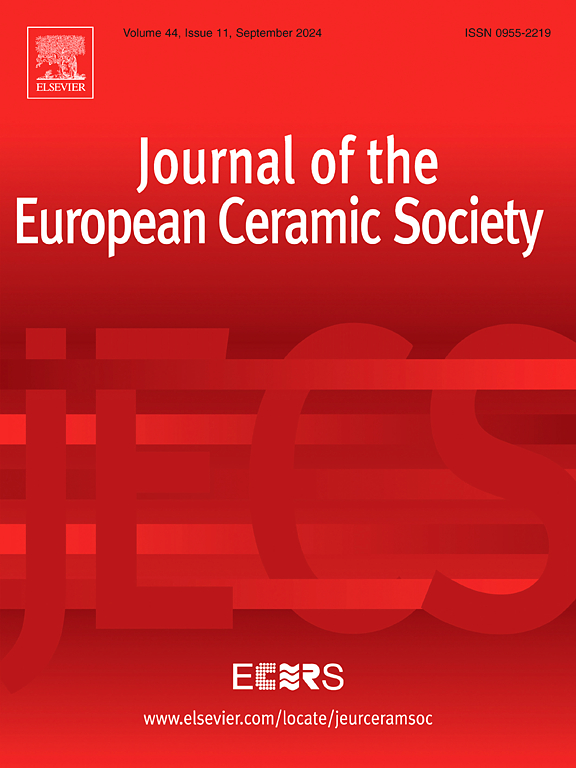氧化钙稳定氧化锆具有高韧性、高强度、耐老化和相变诱发塑性
IF 5.8
2区 材料科学
Q1 MATERIALS SCIENCE, CERAMICS
Journal of The European Ceramic Society
Pub Date : 2025-05-30
DOI:10.1016/j.jeurceramsoc.2025.117581
引用次数: 0
摘要
整体氧化锆陶瓷通常存在韧性、强度和水热老化性能之间的权衡,这突出了开发更好地平衡这些关键性能的新型氧化锆陶瓷的必要性。在本研究中,将含有4.5 摩尔%氧化钙稳定剂(4.5 ca - tzp)的氧化锆从纳米颗粒中压制出来,并在1200-1325℃下进行无压烧结。在1250-1275°C条件下,可以获得完全致密的4.5Ca-TZP,具有纳米微观结构(平均晶粒尺寸<;100 nm)和约20 wt%立方氧化锆。在1250°C和1275°C下烧结时,达到最佳力学性能,四点弯曲强度为1170 ± 140 MPa,单边v形切口梁韧性为9.73 ± 0.45 MPa m1/2。此外,这种纳米氧化锆具有高度的可变形性,在破坏前表现出变形诱导的塑性,从4PB强度的75% %左右开始明显偏离线性行为。引人注目的是,在134°C老化20 小时后,4.5Ca-TZP也具有抗老化性,没有降解。此外,其透明度与传统的3y - tzp相似。本文章由计算机程序翻译,如有差异,请以英文原文为准。
Calcium oxide-stabilized zirconia with high toughness, strength, aging resistance and transformation-induced plasticity
Monolithic zirconia ceramics generally present with trade-offs between toughness, strength and hydrothermal aging-resistance, highlighting the need to develop new zirconia ceramics that are better balanced for these key properties. In this study, zirconia containing 4.5 mol% calcium-oxide stabiliser (4.5Ca-TZP) was pressed from nanoparticles and pressureless sintered at 1200–1325°C. Fully dense 4.5Ca-TZP could be obtained at 1250–1275°C with a nanometric microstructure (average grain size <100 nm) and about 20 wt% cubic-zirconia. Optimal mechanical properties were reached when sintered at 1250°C and 1275°C, combining a four-point-bending (4PB) strength of 1170 ± 140 MPa with a single-edge-V-notched-beam toughness of 9.73 ± 0.45 MPa m1/2. Furthermore, this nanometric zirconia was highly transformable, showing transformation-induced plasticity before failure with an evident deviation from linear behavior starting around 75 % of the 4PB strength. Strikingly, 4.5Ca-TZP was also aging-resistant without degradation observed after 20 hours of aging at 134°C. Additionally, its translucency was similar to that of conventional 3Y-TZPs.
求助全文
通过发布文献求助,成功后即可免费获取论文全文。
去求助
来源期刊

Journal of The European Ceramic Society
工程技术-材料科学:硅酸盐
CiteScore
10.70
自引率
12.30%
发文量
863
审稿时长
35 days
期刊介绍:
The Journal of the European Ceramic Society publishes the results of original research and reviews relating to ceramic materials. Papers of either an experimental or theoretical character will be welcomed on a fully international basis. The emphasis is on novel generic science concerning the relationships between processing, microstructure and properties of polycrystalline ceramics consolidated at high temperature. Papers may relate to any of the conventional categories of ceramic: structural, functional, traditional or composite. The central objective is to sustain a high standard of research quality by means of appropriate reviewing procedures.
 求助内容:
求助内容: 应助结果提醒方式:
应助结果提醒方式:


